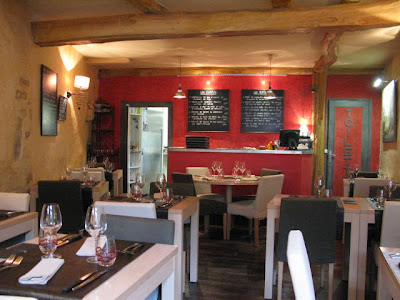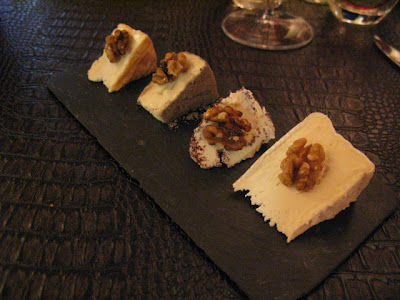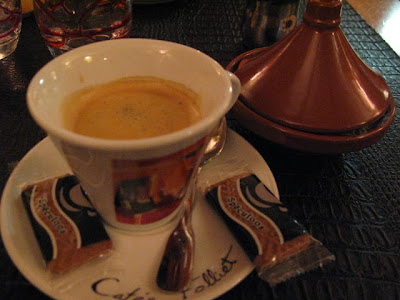Like I do
almost every morning, I got up before Mary and went down the hill to the
boulangerie in Ladoix-Serrigny. Today, I
thought the tartelette de pommes,
apple tart, looked good. Mary made a
happy sound when she opened the bag, so I think it was a good choice.
Our
tasting appointment was at Domaine Rossignol-Trapet in
Gevrey-Chambertin. A few years ago I
managed to obtain several bottles of the Rossignol-Trapet Latricieres-Chambertin
2004, which turned out to be a smash hit at a couple of wine events at our
home. I tried to get an appointment at
the domaine a year ago but was unsuccessful, so I was delighted when they
agreed to see us this year.
The
Rossignol and Trapet families have produced wine in Burgundy for hundreds of
years, dating back to the 1500s, but the Rossignol-Trapet domaine is quite
young. The brothers who run the domaine
are the sons of a marriage of Jacques Rossignol and Mado Trapet. They own vineyards in Gevrey-Chambertin, Beaune,
and Savigny-les-Beaune.
Their
cellar and winery are very new by Burgundy standards, having been constructed
only about 20 years ago and with a modern appearance on the outside.
A
delightful young lady, Aurélie, who works for the Rossignols, took us to the
cellar to taste through their wines. The
wines are stunning, complex, wonderful expressions of their sites. I would be happy to buy them but,
unfortunately, they are not exported to the U.S. Aurélie said she would be glad to ship wines
to us for €175 per case, but that’s too expensive for me. I’ll just have to keep my eye out for it on
auction sites, which is how I acquired the Latricieres-Chambertin a few years ago.
We went
in search of lunch and moseyed into Chambolle-Musigny, another famous wine
village in Burgundy. This is a view down a hill to illustrate how the village is nestled against the hillside.
We parked at l’eglise and noticed the door was
open, so we took a look inside.
The
step at the door was engraved with a prayer, but it is too worn to make
out, reflecting hundreds of years and the steps of countless churchgoers and visitors. I can see the name Joseph and a
reference to “the carpenter,” but that’s about it. We can't tell if it's all French or if some of it is Latin. If anybody reading the blog can shed more
light, please comment!
This
inscription on the wall inside the church is also hard to translate, but seems
to indicate the church was built at least as far back as 1643.
The deterioration
in the statue has to mean the church is very old.
Nice new
hymn books are stacked just inside the church.
Mary, who was raised in the Catholic church and attended Catholic
schools, immediately recognized this hymn.
“Lamb of God, you take away the sins of the world, have mercy on
us. Lamb of God, you take away the sins
of the world, have mercy on us. Lamb of
God, you take away the sins of the world, grant us peace.” The section
headers in red are translated to “God is love,” “People, clap your hands,” and “Joy
of my youth.”
This is the beautiful stained glass above the altar.
Vineyard
workers’ huts like these are common in the vineyards of Burgundy.
This
photo shows how little leafing has occurred so far because of the cold, wet
spring. A closer look below shows the vines
have not bloomed fully, although a few tiny clusters are visible.
We went
to Beaune for lunch at a brasserie on Place Carnot called La Concorde, which
has the appearance of the way we think a brasserie should look.
We
visited an art gallery after lunch, one of those that was closed Sunday. We both liked a painting we saw at the first
gallery, large enough to work over our fireplace at home, a beautiful French
countryside landscape. We agreed we’d be
willing to pay a good price for it, perhaps $1,000 and have it crated and
shipped to Plymouth, Michigan. Inside we
went, like we knew what we were doing, browsed around for a while, and asked
the lady who was tending the gallery, Combien ça coûte? How much does it cost? Her reply was “dix mille euros.” She repeated it in English, I guess because
she noticed the astonished expression on my face. “Ten thousand euros,” about $13,000. We smiled, thanked her, and walked out into
the rain.
Dinner
that evening was at Le P’tit Paradis in Beaune.
We called ahead to make the reservation and when we arrived, guess what …
... we were the first to arrive. We were greeted by
three young women who were sitting on the stoop next door, smoking a
cigarette. One of them invited us to
come on in. In her best English she
said, “Please wait for us. We finish our
smoke.”
In
addition to la carte on the
chalkboard, they were conveniently printed in both French and English. As the restaurant filled, which accommodates
only about 22 people, we could have been at a French restaurant in Chicago. All but one table was populated by Americans.
We had a very nice time, though, starting
with a Crémant de Bourgogne.
Mary didn’t
order an entrée first course, but
nibbled on the pâté de thon avec
croustillants, bread crisps and tuna spread.
I had a sensational first course called Cocotte d’œuf au Lard et Crème d’Asperges
avec Sucette de Parmesan, which translates to coddled egg with bacon and
asparagus cream and a Parmesan cheese lollipop.
The eggs are poached in a cream layer on the bottom with the bacon and
the cream of asparagus is on top. This
is a fabulous dish! I’ve never had
anything like it.
And here’s the
Parmesan lollipop. I must say, it has been a long time since I've had a lollipop!
We both
had Pavé de Charolais au Beurre d’Époisses,
steak with a sauce of butter, cream, and Époisses. Honestly, the steak was ordinary, but the
cheese sauce was amazing! It made the
dinner … we both raved about it! We want
to try this at home.
Delphine, our
delightful and witty server, said it is “old Époisses, new Époisses, and cream,”
as if it is that easy. We can’t wait to
try it on a nice grilled ribeye, sitting with friends on our deck on a nice
summer evening.
The wine
was a Domaine Jean-Pierre Mugneret Vosne-Romanée 2004. It was just the right age for a village-level
wine. Vosne-Romanée is known for wines
of great elegance and I wasn’t sure it would stand up to a hearty steak dish,
but Delphine was enthusiastic about the choice and it did just fine.
It showed
that great Burgundy character of a combination of earthy notes, flowers, perhaps
rose petals, and red and dark fruit aromas.
The palate was silky with a nice mouthfilling texture, good acidity and
good structure to pair with the dish.
Flavors were mostly red and dark fruit, dark cherry, perhaps even plum. It was beautifully balanced, elements of
tannins, acidity, alcohol, and fruit in harmony. The restaurant price was €63.
Mary had
a delicious dessert of Tarte Chocolat-Praliné,
Glace au Lait. You can guess what I had
…
... assiette du fromage, assorted
cheeses.
And coffee, of course.
It was a
lovely evening. The ambience, the food,
Delphine’s personality, the location all combined for a memorable dinner. We held hands and strolled to the end of Rue
Paradis, where I turned around and took this picture with Le P’tit Paradis on
the right.
The
weather cleared up during dinner. Our
car was parked at the end of the street, which is where I took this photo of
the sky over the Beaune rooftops, in the dusky twilight, not yet dark at 10:00
p.m. A happy couple returned to the gite in Magny-les-Villers.
That’s
our post for today. We hope you enjoyed
it. Keep checking back at Cépage et Cuisine as we continue our France adventure. In the meantime,
Cheers!
Mary♥Brian


































No comments:
Post a Comment